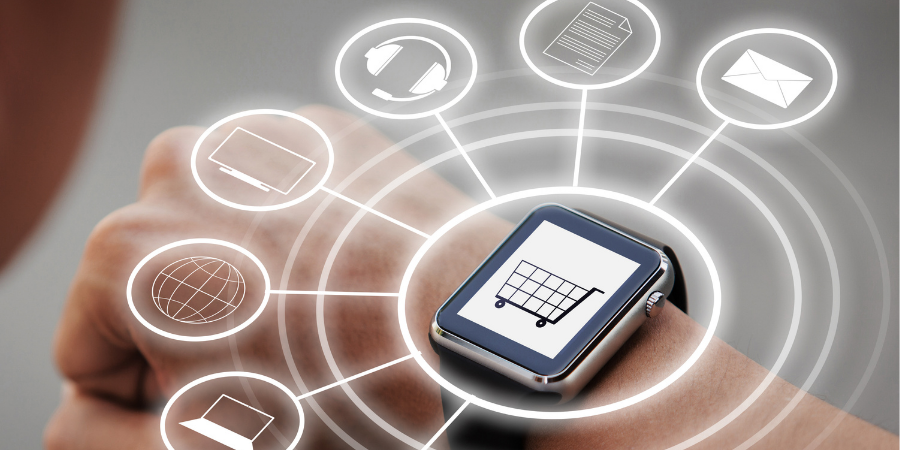
Omnichannel. Unless you're a total newcomer to the business world, you've probably heard this buzzword. But what does it actually mean in practice? And how do you implement an omnichannel e-commerce strategy effectively?
In the past, companies used to offer one communication channel - typically phone calls. While this strategy succeeded in providing an avenue of communication with customers, it was far from ideal. Customers are people, and like all people, they have communication preferences. They also have different lifestyles and work to different schedules. That's why companies started to move towards multichannel strategies. But today, companies are increasingly moving away from multichannel strategies and towards omnichannel, and with good reason! Did you know that businesses with omnichannel customer engagement retain 89% of their customers ? 1 Or that companies using three or more channels in one campaign earn a 287% higher purchase rate than their peers using a single-channel campaign ? 2
An omnichannel strategy used to be a luxury that most companies couldn't afford, but today it's easier than ever. And not only is it straightforward, but it's also essential to surviving in the digital age.
What Is Omnichannel Ecommerce?
Let's start by defining what these terms mean separately and then put them together. Ecommerce is the sale of goods or services over the internet. Omnichannel is a unified experience where customers receive the same understanding of your brand no matter the channel, device, or platform they are using.
So, what is omnichannel e-commerce? Put simply, while a traditional omnichannel experience would include non-digital channels like a brick-and-mortar store, flyers, and in-person conversations, omnichannel e-commerce is only concerned with communication that happens over digital channels. Digital channels include live chat, social media, apps, chatbots, email, web forms, and more.
Multichannel vs. Omnichannel
Many people confuse multichannel and omnichannel, and it's easy to see why. Both strategies involve offering multiple communication touchpoints that customers can interact with. So, what's the difference?The main focus of omnichannel e-commerce is in creating a seamless experience between the multiple digital channels. In multichannel experiences, customers experience a fragmented experience across channels. By contrast, omnichannel strategies anticipate that customers may start on one channel and then move to another as they progress through the online sales journey. When you consider that 98% of Americans switch between devices on the same day 3, the importance of omnichannel strategies becomes self-evident.
Essentially, all omnichannel experiences utilize multiple channels, but not all multi-channel experiences are omnichannel.
The Benefits of Omnichannel Ecommerce
- Increased Sales and Traffic - One study of 46,000 shoppers found that omnichannel e-commerce customers spend more money than their single-channel customer peers4 .
- Improved Customer Experience - According to one study by UC Today, 9/10 customers want an omnichannel experience.5 They want seamless integration between devices and touchpoints. By offering an omnichannel e-commerce experience, you can meet and even exceed customer expectations.
- Boosted Customer Loyalty - When customers have an excellent shopping experience, they're more likely to come back for more and become loyal customers. Keeping your existing customers happy is paramount; one study found that the probability of selling to an existing customer is 60-70%.6
- Understanding Your Customer Journey - Omnichannel ecommerce platforms typically come with customer analysis tools. These tools allow you to collect data from multiple channels and gain insight into what customers respond to. Armed with these insights, you can create personalized experiences that drive more sales.
Next Steps - How to Cultivate an Omnichannel Ecommerce Experience
Cultivating an omnichannel ecommerce experience starts with how you design your website and which technology you choose to support your online business.
The buyer journey starts the moment a customer reaches your site, so having an attractive homepage is essential. But, equally crucial is ensuring your website offers a cohesive experience free from friction. Put simply, if you break their immersion and give them something to complain about, they'll bounce quicker than you can say omnichannel.
To create this immersive experience, you need to choose the right publishing platform for your needs. For example, Batoi CloudSpace offers a way to publish your e-commerce storefront and publish content in different formats (text, image, documents, archive files, audios, and videos), through which customers can engage. It also supports time-bound content that is highly relevant and encourages visitors to take action today.
On the backend, there's one thing all thriving e-commerce businesses have in common - behind-the-scenes software that supports frictionless workflows for managing the business. This means automation tools that make sales, billing, and any business projects seamless and straightforward. An example of this type of workflow management tool is Batoi Hub.
-
https://www.invespcro.com/blog/state-of-omnichannel-shopping/ ↩
-
https://www.forbes.com/sites/forbescommunicationscouncil/2017/10/27/four-steps-to-master-omnichannel-marketing/?sh=1a3787d16d5d ↩
-
https://hbr.org/2017/01/a-study-of-46000-shoppers-shows-that-omnichannel-retailing-works ↩
-
https://www.cxtoday.com/contact-centre/delivering-an-excellent-omni-channel-experience/ ↩
-
https://www.smallbizgenius.net/by-the-numbers/customer-loyalty-statistics/#gref ↩

 Batoi Corporate Office
Batoi Corporate Office